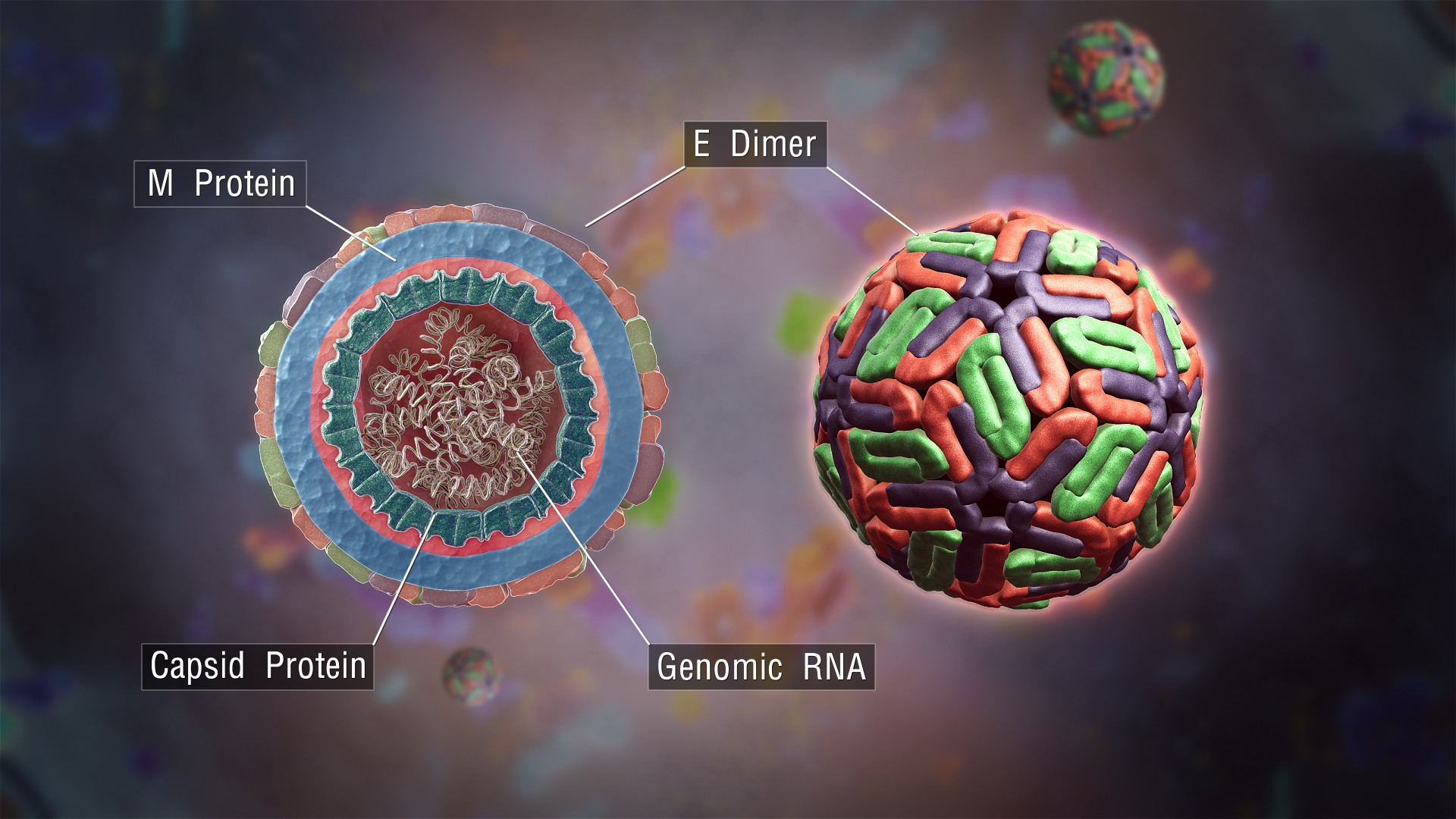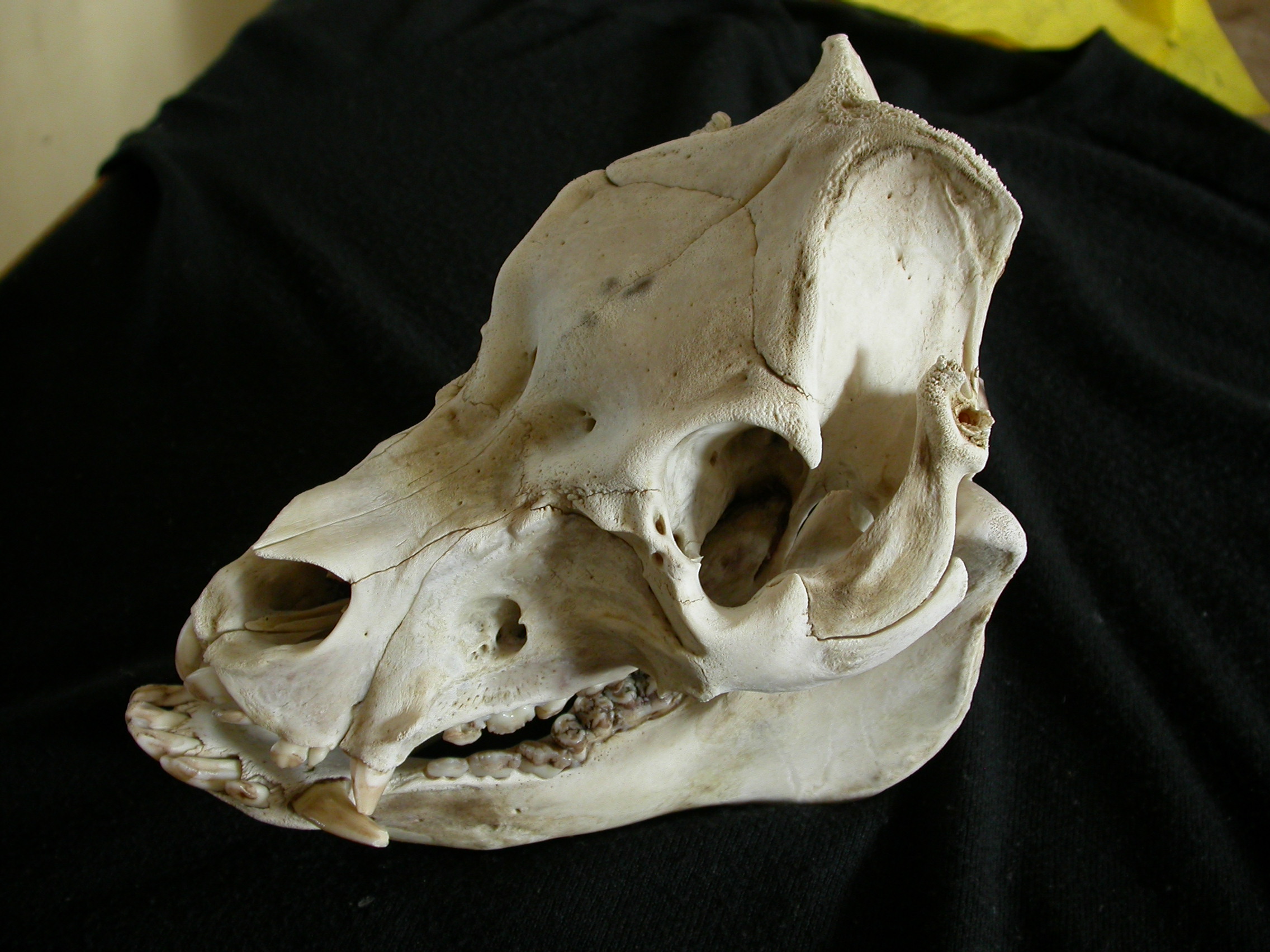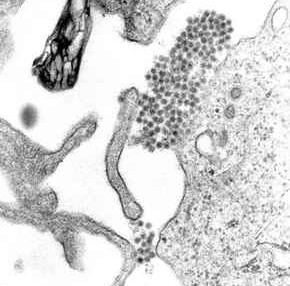|
Arbovirus
Arbovirus is an informal name for any virus that is transmitted by arthropod vectors. The term ''arbovirus'' is a portmanteau word (''ar''thropod-''bo''rne ''virus''). ''Tibovirus'' (''ti''ck-''bo''rne ''virus'') is sometimes used to more specifically describe viruses transmitted by ticks, a superorder within the arthropods. Arboviruses can affect both animals (including humans) and plants. In humans, symptoms of arbovirus infection generally occur 3–15 days after exposure to the virus and last three or four days. The most common clinical features of infection are fever, headache, and malaise, but encephalitis and viral hemorrhagic fever may also occur. Signs and symptoms The incubation period – the time between when infection occurs and when symptoms appear – varies from virus to virus, but is usually limited between 2 and 15 days for arboviruses. The majority of infections, however, are asymptomatic. Among cases in which symptoms do appear, symptoms tend to be non- ... [...More Info...] [...Related Items...] OR: [Wikipedia] [Google] [Baidu] |
Culex
''Culex'' is a genus of mosquitoes, several species of which serve as vectors of one or more important diseases of birds, humans, and other animals. The diseases they vector include arbovirus infections such as West Nile virus, Japanese encephalitis, or St. Louis encephalitis, but also filariasis and avian malaria. They occur worldwide except for the extreme northern parts of the temperate zone, and are the most common form of mosquito encountered in some major U.S. cities, such as Los Angeles. Etymology In naming this genus, Carl Linnaeus appropriated the nonspecific Latin term for a midge or gnat: '. Description Depending on the species, the adult ''Culex'' mosquito may measure from . The adult morphology is typical of flies in the suborder Nematocera with the head, thorax, and abdomen clearly defined and the two forewings held horizontally over the abdomen when at rest. As in all Diptera capable of flight, the second pair of wings is reduced and modified into tiny, ... [...More Info...] [...Related Items...] OR: [Wikipedia] [Google] [Baidu] |
Meningitis
Meningitis is acute or chronic inflammation of the protective membranes covering the brain and spinal cord, collectively called the meninges. The most common symptoms are fever, headache, and neck stiffness. Other symptoms include confusion or altered consciousness, nausea, vomiting, and an inability to tolerate light or loud noises. Young children often exhibit only nonspecific symptoms, such as irritability, drowsiness, or poor feeding. A non-blanching rash (a rash that does not fade when a glass is rolled over it) may also be present. The inflammation may be caused by infection with viruses, bacteria or other microorganisms. Non-infectious causes include malignancy (cancer), subarachnoid haemorrhage, chronic inflammatory disease (sarcoidosis) and certain drugs. Meningitis can be life-threatening because of the inflammation's proximity to the brain and spinal cord; therefore, the condition is classified as a medical emergency. A lumbar puncture, in which a needle is ... [...More Info...] [...Related Items...] OR: [Wikipedia] [Google] [Baidu] |
Dengue Virus
''Dengue virus'' (DENV) is the cause of dengue fever. It is a mosquito-borne, single positive-stranded RNA virus of the family ''Flaviviridae''; genus ''Flavivirus''. Four serotypes of the virus have been found, a reported fifth has yet to be confirmed,Dwivedi, V. D., Tripathi, I. P., Tripathi, R. C., Bharadwaj, S., & Mishra, S. K. (2017). Genomics, proteomics and evolution of ''Dengue virus''. Briefings in functional genomics.16(4): 217–227, https://doi.org/10.1093/bfgp/elw040 all of which can cause the full spectrum of disease. Nevertheless, scientists' understanding of dengue virus may be simplistic as, rather than distinct antigenic groups, a ''continuum'' appears to exist. This same study identified 47 strains of ''dengue virus''. Additionally, coinfection with and lack of rapid tests for ''zika virus'' and ''chikungunya'' complicate matters in real-world infections. ''Dengue virus'' has increased dramatically within the last 20 years, becoming one of the worst mosquito ... [...More Info...] [...Related Items...] OR: [Wikipedia] [Google] [Baidu] |
Encephalitis
Encephalitis is inflammation of the Human brain, brain. The severity can be variable with symptoms including reduction or alteration in consciousness, headache, fever, confusion, a stiff neck, and vomiting. Complications may include seizures, hallucinations, trouble speaking, memory problems, and problems with hearing. Causes of encephalitis include viruses such as herpes simplex virus and rabies virus as well as bacteria, fungi, or parasites. Other causes include autoimmune diseases and certain medications. In many cases the cause remains unknown. Risk factors include a immunosuppression, weak immune system. Diagnosis is typically based on symptoms and supported by blood tests, medical imaging, and analysis of cerebrospinal fluid. Certain types are preventable with vaccines. Treatment may include antiviral medications (such as acyclovir), anticonvulsants, and corticosteroids. Treatment generally takes place in hospital. Some people require artificial respiration. Once the immedi ... [...More Info...] [...Related Items...] OR: [Wikipedia] [Google] [Baidu] |
Myalgia
Myalgia (also called muscle pain and muscle ache in layman's terms) is the medical term for muscle pain. Myalgia is a symptom of many diseases. The most common cause of acute myalgia is the overuse of a muscle or group of muscles; another likely cause is viral infection, especially when there has been no trauma. Long-lasting myalgia can be caused by metabolic myopathy, some nutritional deficiencies, and chronic fatigue syndrome. Causes The most common causes of myalgia are overuse, injury, and strain. Myalgia might also be caused by allergies, diseases, medications, or as a response to a vaccination. Dehydration at times results in muscle pain as well, especially for people involved in extensive physical activities such as workout. Muscle pain is also a common symptom in a variety of diseases, including infectious diseases, such as influenza, muscle abscesses, Lyme disease, malaria, trichinosis or poliomyelitis; autoimmune diseases, such as celiac disease, systemi ... [...More Info...] [...Related Items...] OR: [Wikipedia] [Google] [Baidu] |
Wader
245px, A flock of Red_knot.html" ;"title="Dunlins and Red knot">Dunlins and Red knots Waders or shorebirds are birds of the order Charadriiformes commonly found wikt:wade#Etymology 1, wading along shorelines and mudflats in order to foraging, forage for food crawling or burrowing in the mud and sand, usually small arthropods such as aquatic insects or crustaceans. The term "wader" is used in Europe, while "shorebird" is used in North America, where "wader" may be used instead to refer to long-legged wading birds such as storks and herons. There are about 210 species of wader, most of which live in wetland or coastal environments. Many species of Arctic and temperate regions are strongly migratory, but tropical birds are often resident, or move only in response to rainfall patterns. Some of the Arctic species, such as the little stint, are amongst the longest distance migrants, spending the non- breeding season in the southern hemisphere. Many of the smaller species found ... [...More Info...] [...Related Items...] OR: [Wikipedia] [Google] [Baidu] |
Domestic Pig
The pig (''Sus domesticus''), often called swine, hog, or domestic pig when distinguishing from other members of the genus ''Sus'', is an omnivorous, domesticated, even-toed, hoofed mammal. It is variously considered a subspecies of ''Sus scrofa'' (the wild boar or Eurasian boar) or a distinct species. The pig's head-plus-body length ranges from , and adult pigs typically weigh between , with well-fed individuals even exceeding this range. The size and weight of hogs largely depends on their breed. Compared to other artiodactyls, a pig's head is relatively long and pointed. Most even-toed ungulates are herbivorous, but pigs are omnivores, like their wild relative. Pigs grunt and make snorting sounds. When used as livestock, pigs are farmed primarily for the production of meat, called pork. A group of pigs is called a ''passel'', a ''team'', or a ''sounder''. The animal's bones, hide, and bristles are also used in products. Pigs, especially miniature breeds, are kept a ... [...More Info...] [...Related Items...] OR: [Wikipedia] [Google] [Baidu] |
Culex Tritaeniorhynchus
''Culex (Culex) tritaeniorhynchus'' is a species of mosquito and is the main vector of the disease Japanese encephalitis. This mosquito is a native of northern Asia, and parts of Africa (northeast and sub-Saharan). Females target large animals for blood extraction, including cattle and swine, and are strongly anthropophilic. Habitat The larval habitat of ''Cx. tritaeniorhynchus'' primarily consists of low lying water logged areas such as grasses and fallow rice fields, but this species can also be found in wells, ponds, ditches and has been reported in urban environments in close proximity to human populations, such as water storage containers in houses. ''Culex tritaeniorhynchus'' is extremely common and widespread. It can be found in locations where the annual mean temperature ranges from 8.2 - 28.9°C, with elevations of a maximum 838m above sea level. Recorded presence of ''Cx. tritaeniorhynchus'' through surveys and mosquito collections list the species as being present ... [...More Info...] [...Related Items...] OR: [Wikipedia] [Google] [Baidu] |
Japanese Encephalitis
Japanese encephalitis (JE) is an infection of the brain caused by the Japanese encephalitis virus (JEV). While most infections result in little or no symptoms, occasional inflammation of the brain occurs. In these cases, symptoms may include headache, vomiting, fever, confusion and seizures. This occurs about 5 to 15 days after infection. JEV is generally spread by mosquitoes, specifically those of the '' Culex'' type. Pigs and wild birds serve as a reservoir for the virus. The disease occurs mostly outside of cities. Diagnosis is based on blood or cerebrospinal fluid testing. Prevention is generally with the Japanese encephalitis vaccine, which is both safe and effective. Other measures include avoiding mosquito bites. Once infected, there is no specific treatment, with care being supportive. This is generally carried out in a hospital. Permanent problems occur in up to half of people who recover from JE. The disease primarily occurs in East and Southeast Asia as wel ... [...More Info...] [...Related Items...] OR: [Wikipedia] [Google] [Baidu] |
Shock (circulatory)
Shock is the state of insufficient blood flow to the tissues of the body as a result of problems with the circulatory system. Initial symptoms of shock may include weakness, fast heart rate, fast breathing, sweating, anxiety, and increased thirst. This may be followed by confusion, unconsciousness, or cardiac arrest, as complications worsen. Shock is divided into four main types based on the underlying cause: low volume, cardiogenic, obstructive, and distributive shock. Low volume shock, also known as hypovolemic shock, may be from bleeding, diarrhea, or vomiting. Cardiogenic shock may be due to a heart attack or cardiac contusion. Obstructive shock may be due to cardiac tamponade or a tension pneumothorax. Distributive shock may be due to sepsis, anaphylaxis, injury to the upper spinal cord, or certain overdoses. The diagnosis is generally based on a combination of symptoms, physical examination, and laboratory tests. A decreased pulse pressure ( systolic blood ... [...More Info...] [...Related Items...] OR: [Wikipedia] [Google] [Baidu] |
Dengue Fever
Dengue fever is a mosquito-borne tropical disease caused by the dengue virus. Symptoms typically begin three to fourteen days after infection. These may include a high fever, headache, vomiting, muscle and joint pains, and a characteristic skin itching and skin rash. Recovery generally takes two to seven days. In a small proportion of cases, the disease develops into a more severe dengue hemorrhagic fever, resulting in bleeding, low levels of blood platelets and blood plasma leakage, or into dengue shock syndrome, where dangerously low blood pressure occurs. Dengue is spread by several species of female mosquitoes of the '' Aedes'' genus, principally ''Aedes aegypti''. The virus has five serotypes; infection with one type usually gives lifelong immunity to that type, but only short-term immunity to the others. Subsequent infection with a different type increases the risk of severe complications. A number of tests are available to confirm the diagnosis including detecti ... [...More Info...] [...Related Items...] OR: [Wikipedia] [Google] [Baidu] |






